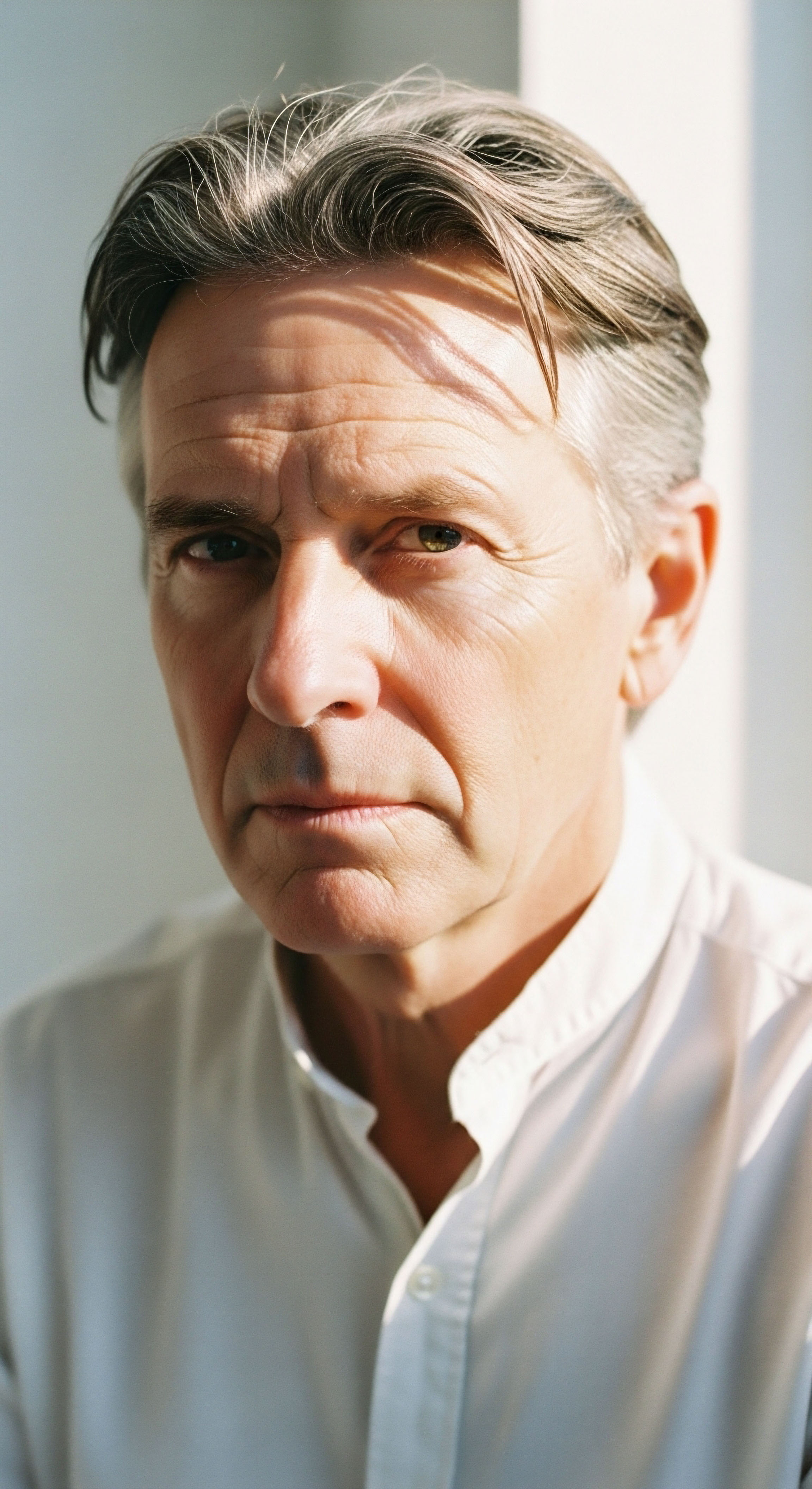

The Fading Signal of the Endocrine System
The passive acceptance of biological decay is a design flaw in modern health philosophy. True longevity is defined by sustained vitality, not merely the absence of acute disease. The core challenge facing the individual committed to perpetual youth resides in the slow, systemic degradation of the endocrine control loops. This decline is not anecdotal; it is a measurable, physiological event that erodes performance from the cellular level outward.

The Erosion of Command Authority
The Hypothalamic-Pituitary-Gonadal (HPG) axis functions as the body’s master control panel for anabolism, drive, and metabolic rate. Age introduces a phenomenon known as ‘hypothalamic desensitization,’ a reduction in the system’s ability to issue and receive clear, strong hormonal commands. The body’s capacity for regeneration diminishes because the signal from the command center to the periphery ∞ muscle, bone, brain ∞ has become weak and distorted.
Testosterone, DHEA, and growth hormone (GH) are the primary chemical messengers of youth. Their systemic decline begins predictably in the third decade of life. The reduction in free testosterone, for instance, correlates directly with a loss of lean muscle mass, decreased bone mineral density, and a tangible reduction in cognitive processing speed.
The average decline in total testosterone is documented at 1 to 2 percent per year after age 30, representing a significant erosion of the biological foundation for performance.

Performance Metrics Are Biological Metrics
The pursuit of perpetual youth reframes the discussion of aging. It shifts the focus from managing symptoms to restoring system-wide capacity. The brain fog, the stubborn visceral fat, the protracted recovery time ∞ these are quantifiable data points reflecting a compromised endocrine environment. These are not character flaws or inevitable consequences; they are the result of diminished chemical signaling that must be corrected with clinical precision.
- Cognitive Drive: Direct correlation between optimized free hormone levels and sustained executive function.
- Metabolic Efficiency: The body’s capacity to switch fuel sources (glucose to fat) is regulated by key metabolic hormones.
- Structural Integrity: Hormonal signaling drives the cellular repair mechanisms in muscle and connective tissue.


The Science of Signaling Molecules
Systemic recalibration requires a targeted intervention, moving beyond mere supplementation to a pharmaceutical-grade replacement and signaling strategy. The method involves supplying the exact molecules the body has ceased to produce at peak levels and introducing specific peptides to deliver new, precise instructions to the cellular machinery.

Restoring the Master Volume
Hormone Replacement Therapy (HRT) acts as the foundation, restoring the endocrine baseline to a youthful, functional set point. For men, this centers on Testosterone Replacement Therapy (TRT); for women, a balanced approach to estrogen, progesterone, and testosterone. The goal is to return serum levels to the high-normal range, a position of biological advantage, not merely to avoid clinical deficiency.
This is a titration process. The correct protocol is one that mirrors the body’s natural diurnal rhythm and pharmacokinetics, minimizing side effects while maximizing the physiological benefit. It is a precise act of biochemical restoration, demanding meticulous monitoring of hematocrit, estradiol, and PSA for men, and a comprehensive panel for women.

Peptides the New Instructions
Peptide science introduces a layer of sophistication to the process. Peptides are short-chain amino acids that act as highly specific signaling molecules. They do not merely replace; they instruct. They tell the body to perform specific tasks, such as stimulating growth hormone release or repairing tissue. This approach delivers a precision not possible with broad-spectrum hormone replacement alone.
A therapeutic stack often includes agents that influence the Growth Hormone Releasing Hormone (GHRH) axis. These compounds increase the amplitude and frequency of the body’s natural GH pulse, leading to improved body composition, enhanced recovery, and better sleep quality. This is a subtle yet powerful method of reversing age-related decline in cellular regeneration.
The true mastery of the ‘how’ lies in the stacking of these interventions. A synergistic approach ensures that the hormonal foundation is solid, while the peptides provide the targeted, high-resolution instructions for cellular performance.
| System Target | Intervention Class | Primary Action |
|---|---|---|
| Endocrine Baseline | Hormone Replacement | Restores serum concentration to peak physiological range. |
| Cellular Regeneration | Growth Hormone Secretagogues | Increases endogenous GH pulse amplitude and frequency. |
| Tissue Repair & Recovery | Targeted Peptides (e.g. BPC-157) | Delivers specific signaling for accelerated healing and reduced inflammation. |


Biological Return on Investment
The pursuit of peak performance demands an understanding of the timeline. This is not a quick fix; it is a multi-phase system upgrade. The effects of endocrine recalibration unfold across a predictable, data-driven curve, moving from initial symptomatic relief to complete physiological restructuring.

Phase One the Symptomatic Correction
The initial response to HRT or a peptide protocol occurs rapidly. Within the first two to four weeks, the subjective metrics of well-being improve. Sleep quality deepens, mental clarity sharpens, and a distinct increase in drive and motivation returns. This phase is driven by the rapid saturation of key hormone receptors in the central nervous system and the initial metabolic shifts.
Patients typically report significant improvements in mood, sleep, and energy within the first month of optimized hormone protocols, validating the immediate neurological impact of chemical balance.

Phase Two the Structural Reset
The structural changes require more time, reflecting the slow, deliberate process of cellular turnover and protein synthesis. Between three and six months, the body composition shifts accelerate. Lean muscle mass increases, body fat reduces, and strength gains become tangible. This is the period when the interventions begin to affect gene expression, signaling the body to revert to a more youthful pattern of tissue construction and energy storage.
This phase is where commitment to lifestyle inputs ∞ high-intensity resistance training and precise nutritional timing ∞ pays its highest dividend. The therapeutic agents have provided the superior raw materials and instructions; the physical stimulus is what forces the cellular adaptation. The return on investment is maximized by synchronizing the chemistry with the mechanics.
- Week 1-4: Cognitive and Mood Elevation. Enhanced sleep quality and subjective drive.
- Month 2-3: Metabolic Shift. Increased basal metabolic rate and initial fat loss acceleration.
- Month 4-6: Musculoskeletal Restructuring. Significant gains in lean mass, strength, and bone density.
- Month 6+: Stabilization and Maintenance. Establishment of a new, high-performance physiological set point.
The ‘when’ is always now. Delay is simply the compounding of biological debt. The objective is to establish the new hormonal equilibrium as quickly and safely as possible to maximize the years spent operating at peak capacity.

The Only Metric That Matters Is Output
The ultimate measure of a life well-lived is not the chronological number on a document, but the sustained quality and quantity of output ∞ the mental clarity, the physical capacity, the depth of presence. The Proactive Pursuit of Perpetual Youth is a mandate for those who refuse to accept biological decline as destiny.
It is the application of advanced science to a fundamental truth ∞ the human body is a system that can be tuned, maintained, and elevated far beyond the accepted norms of aging.
The commitment to this path is an acknowledgment that high performance is not accidental; it is chemically and structurally engineered. The Vitality Architect does not simply add years to life; the architect adds life to the years, ensuring the highest possible expression of self is maintained until the final moment of contribution.



